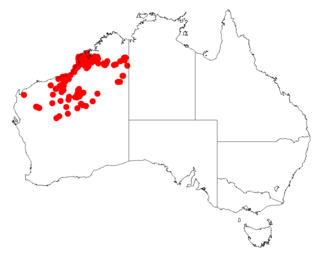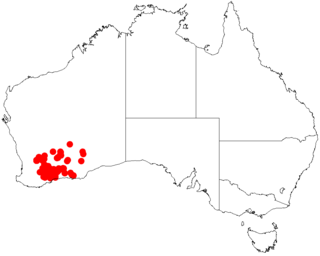
Acacia murrayana is a tree in the family Fabaceae. It has numerous common names, including sandplain wattle, Murray's wattle, fire wattle, colony wattle and powder bark wattle that is endemic to arid areas in every mainland State except Victoria.

Acacia pyrifolia, commonly known as ranji bush is a shrub that is endemic to the north of Western Australia.

Acacia eriopoda, commonly known as the Broome pindan wattle and the narrow-leaf pindan wattle, is a species of wattle in the legume family that is native to northern Western Australia. It is also known as Yirrakulu to the Nyangumarta peoples.

Acacia spondylophylla, commonly known as curry wattle or spine-leaf wattle, is a small, flat topped shrub native to central and western Australia. The leaves, which are arranged on spaced whorls around the stem, have a distinctive curry-like smell.
Acacia anastomosa, also known as Carson River wattle, is a shrub belonging to the genus Acacia and the subgenus Juliflorae that is endemic to north western Australia.

Acacia diastemata, also known as the sandstone pavement wattle, is a shrub to small tree belonging to the genus Acacia and the subgenus Juliflorae that is endemic to a small area of north-western Australia.
Acacia gibsonii, commonly known as Gibson's wattle, is a shrub belonging to the genus Acacia and the subgenus Juliflorae.

Acacia phacelia, also known as the Kimberley cluster wattle, is a shrub belonging to the genus Acacia and the subgenus Juliflorae that is endemic to a small area in north western Australia.
Acacia seclusa, commonly known as saw range wattle, is a small tree belonging to the genus Acacia and the subgenus Juliflorae that is endemic to northern Australia.
Acacia sulcaticaulis, also commonly known as the Mount Mulgine fluted wattle, is a shrub or tree belonging to the genus Acacia and the subgenus Juliflorae that is native to a small area in western Australia.
Acacia synantha, also known as sandstone synchronous wattle, is a tree or shrub belonging to the genus Acacia and the subgenus Juliflorae. It is native to a small area in the Kimberley region of Western Australia.

Acacia umbraculiformis, commonly known as western umbrella wattle, is a tree belonging to the genus Acacia and the subgenus Juliflorae native to western Australia.
Acacia claviseta, also known as the club-tipped whorled wattle, is a shrub belonging to the genus Acacia and the subgenus Lycopodiifoliae that is endemic to north western Australia.

Acacia melleodora, commonly known as scented wax wattle, waxy wattle, honey wattle or honey scented wattle, is a shrub belonging to the genus Acacia and the subgenus Phyllodineae that is endemic to arid parts of central Australia.
Acacia anserina, also known as hairy sandstone wattle, is a shrub of the genus Acacia and the subgenus Plurinerves. It is native to a small area in the Kimberley region of Western Australia.

Acacia heteroclita is a shrub or tree of the genus Acacia and the subgenus Plurinerves that is endemic to south western Australia.

Acacia kenneallyi is a shrub or tree of the genus Acacia and the subgenus Plurinerves that is endemic to north western Australia.
Acacia obtriangularis, also commonly knowns as Lawley River wattle, is a shrub of the genus Acacia and the subgenus Plurinerves that is endemic to a small area of north western Australia.

Acacia uncinella is a shrub of the genus Acacia and the subgenus Plurinerves that is endemic to an area of south western Australia.

Acacia saxicola, commonly known as Mount Maroon wattle, is a shrub belonging to the genus Acacia and the subgenus Phyllodineae native to eastern Australia.











